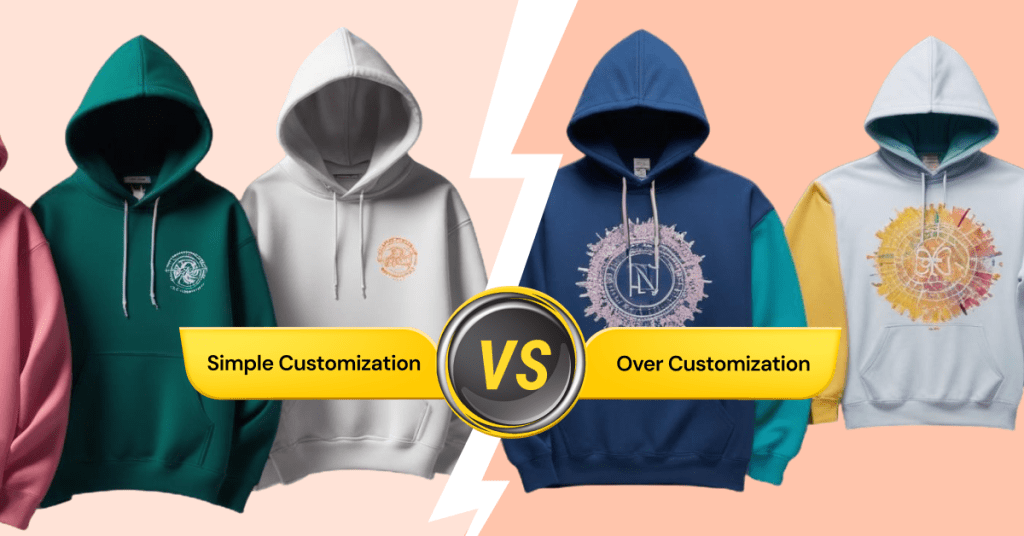
Last Updated on February 8, 2025
In the age of personalization, do offering too many options damage your brand’s identity? A notable example is the once-popular fast-food chain, Subway. At one point, Subway offered over 38 million sandwich combinations, aiming to cater to every possible taste. However, this overwhelming array of choices led to inconsistent customer experiences and a diluted brand identity, causing confusion rather than clarity. Maintaining a strong brand identity is crucial for customer loyalty and recognition. While customization is essential, excessive flexibility can cause serious brand identity customization risks, such as inconsistent brand perception and diluted market positioning. This can lead to a lack of brand consistency and confuse consumers about what the brand truly represents.
Table of Contents
The Importance of Brand Identity
Brand identity is the visual and emotional representation of a brand that helps it stand out in the market. It encompasses elements such as the logo, color scheme, typography, and messaging that collectively convey the brand’s values and personality. A strong brand identity plays a crucial role in building trust, consistency, and loyalty among consumers. When customers recognize and relate to a brand’s identity, they are more likely to trust the brand and remain loyal to it.
For example, imagine Apple. Premium quality, innovation, and sleek design are the core elements of Apple’s brand identity. They have a strong emotional bond with customers as a result of their simple look and messages that is both simple and visually appealing. Nike also hits an intuitive connection with their target audience with its “Just Do It” slogan and unique swoosh logo, which stand for empowerment and athletic achievement.
However, brands face brand identity customization challenges when they attempt to cater to diverse consumer preferences. Brand identity customization strategies must prioritize consistency to avoid diluting their core message. Striking the right balance between personalization and maintaining a cohesive brand identity is essential to ensure that the brand remains recognizable and trustworthy in the eyes of consumers.
What is Over-Customization?
In the context of eCommerce and product personalization, over-customization refers to providing customers with an excessive number of options and choices. This can involve offering too many design options on products, such as colors, patterns, and features, or creating overly broad messaging that tries to appeal to everyone. While the intention behind extensive customization is to cater to individual preferences and enhance customer satisfaction, it can backfire in several ways.
For example, imagine an online store that allows customers to design their own sneakers. If the store offers thousands of combinations of colors, materials, and patterns, customers might feel overwhelmed by the sheer number of choices. This decision paralysis can lead to frustration and abandonment of the purchase process. Additionally, the store’s brand identity customization could become diluted, as the consistent visual and emotional cues that define the brand are lost amidst the plethora of options.
Over-customization can also create confusion and reduce the brand’s recognizability. When a brand’s messaging is too broad, trying to cater to every possible customer segment, it can lose its unique voice and personality. Customers may struggle to understand what the brand stands for and what makes it different from competitors. This lack of clarity can weaken the emotional connection between the brand and its audience, ultimately affecting customer loyalty and trust.
How Over-Customization Weakens Brand Identity
1. Loss of Consistency
Providing too many options can lead to a fragmented brand image. When a brand offers an overwhelming array of choices, it becomes difficult to maintain a cohesive visual and emotional representation. Consistency in branding elements such as color schemes, typography, and messaging is crucial for creating a recognizable identity. According to a study by Lucidpress, consistent brand presentation across all platforms can increase revenue by up to 23%. However, over-customization can disrupt this consistency, causing confusion among consumers and weakening the brand’s identity.
Brand identity customization requires careful planning to avoid overwhelming consumers with choices, ensuring the brand maintains a clear, cohesive identity across all customer interactions.

2. Decision Fatigue
Overwhelming customers with too many options can result in decision fatigue. When faced with an excessive number of choices, consumers may feel stressed and fatigued, leading to a negative shopping experience. This phenomenon, known as decision fatigue, can cause customers to abandon their purchase or make less satisfactory choices. A study published in the journal “Trends in Cognitive Sciences” highlights that decision fatigue impairs the ability to make quality decisions, ultimately harming customer satisfaction and loyalty.
3. Reduced Recognizability
Inconsistent visuals and messaging can confuse customers and reduce a brand’s recognizability. When a brand’s identity becomes diluted due to excessive customization, it loses its unique voice and personality. Customers may struggle to understand what the brand stands for and what differentiates it from competitors. The Harvard Business Review emphasizes that strong brands maintain a clear and consistent identity, which helps build trust and loyalty among consumers. Over-customization challenges brand identity customization by introducing variability that can erode the brand’s core message and visual identity.
The Balance Between Customization and Consistency on Shopify
Finding the sweet spot between offering customization and maintaining a strong brand identity is key to success. Restricting customization options to those that align with the brand’s core values helps mitigate brand identity customization risks and ensures every choice reinforces the brand’s core message. For example, if you run a sustainable clothing store on Shopify, you should only offer eco-friendly customization choices.
Additionally, providing pre-set designs or templates that reflect your brand’s visual identity minimizes branding challenges customization. For instance, offering custom t-shirts with pre-designed covers that adhere to your brand’s aesthetic can be effective.

Ensuring that customizable products on Shopify incorporate branded colors, fonts, and design elements addresses brand identity customization risks by making sure personalized items still represent your brand. For example, a coffee shop selling custom mugs through Shopify can feature the shop’s signature colors and logo in the customization options.
Real-world examples of brands on Shopify that balance customization and identity effectively include small independent businesses that offer personalized products within a curated range, maintaining a consistent brand image. By implementing these strategies on your Shopify store, you can navigate branding challenges customization and offer personalized experiences without sacrificing your core identity.
Best Practices to Avoid Over-Customization
To strike a balance between personalization and maintaining brand identity, follow these actionable tips:
1. Establish Guidelines for Customization Options
- Define clear guidelines for the types of customization you offer, such as colors, fonts, and patterns.
- Ensure that all customization choices align with your brand values and aesthetic.
2. Test Customization Features with a Small Audience
- Before rolling out customization options to all customers, test them with a small, select group.
- Gather feedback and assess how well the customization features are received
3. Monitor Feedback and Adjust Customization Options Accordingly
- Continuously monitor customer feedback on your customization options.
- Be prepared to make adjustments based on feedback to ensure the customization options enhance the brand experience without causing confusion.
Last words
Over-customization can pose significant brand identity customization risks, leading to a diluted and inconsistent brand image. To maintain a balance, it is essential to establish clear guidelines, conduct small-scale testing, and continuously monitor user feedback. By doing so, you can navigate the branding challenges customization poses, ensuring your brand remains strong and consistent while offering personalized experiences.

